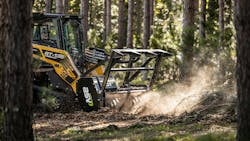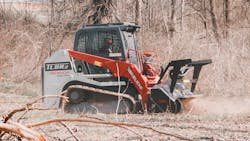Brush clearing attachments streamline land management
In the past, land clearing meant pushing vegetation to the side with dozers and excavators.
Now, site preparation and land-clearing work are becoming more about land management and environmental responsibility. As a result, manufacturers are meeting the need for more diverse land-clearing tools by widening their range of equipment, giving equipment managers more ways to address new opportunities.
One example is brush cutters and mulchers previously designed to be mounted on dozers or large-frame and high-flow skid steers and compact track loaders. These attachments have since become more efficient and can be used on smaller, midframe machines.
As the market opens up for smaller carriers, manufacturers are leveraging enhancements in attachments such as hydraulic versatility rather than placing focus on machines solely dedicated to land clearing.
“We have a wide breadth of grapples, stump grinders, and other attachments that enhance the utilization of the main carrier,” says Mike Fitzgerald, marketing manager for Bobcat. “On our machines we have standard flow, or high flow, and—on our latest machines, the T86 and S86 loaders—we’ve got superflow. So, we offer a range of gpm from the high teens to the low twenties and work our way all the way up into the super flow where we’re at 42 gpm at 4000 psi. We try and match the attachment to what flow is on the machine, and the performance is dictated accordingly.”
Equipment managers that decide to use attachments rather than a purpose-built land-clearing machine need to be able to match equipment features to attachment in order to garner the desired results.
Key hydraulic features
To optimize the wide variety of attachments available, manufacturers seem to be implementing wider ranges of auxiliary flow rates and the ability to easily change hydraulically driven attachments.
One example comes from ASV, with its RT-135 Forestry and RT-75 Heavy Duty Posi-Track loaders, which “match up perfectly to land-clearing attachments,” according to the company. “The RT-135F uses a 132-horsepower Cummins engine combined with a 50-gpm maximum auxiliary flow and oversized auxiliary pump of 66 gpm,” says Buck Storlie, product manager for ASV.
“The extra 16 gpm within the pump means operators can run high-flow attachments, such as our new mulchers, at full speed while moving the loader without slowing down the tool.”
Read also: Small skid steers gain grade control
With such a range of hydraulic flow, both the RT-135F and RT-75HD can transfer more flow and pressure directly to the attachment. ASV has done this by using larger hydraulic lines, hydraulic coolers, and direct-drive pumps rather than beltdriven pumps.
Additions like these will help prevent power loss, as well as a loss of productivity in more challenging applications, according to the company.
End users are eyeing opportunities in more applications: removing grass to clearing brush and small trees to taking down trees up to 12 inches in diameter. To ensure productivity in all applications, carriers must be able to switch easily between attachments.
Takeuchi offers excavators that feature a dedicated coupler circuit unit that, when used with an optional hydraulic pin grabber coupler, “allows for the quick and easy exchange of various buckets and hydraulically driven attachments,” according to Lee Padgett, product manager at Takeuchi. Utilizing this feature will enable smoother clearing experience, and quicker work times.
Takeuchi’s TSCL/HY compact stump cutter features a hydraulically adjustable front hood to prevent the ejection of mulched material and is designed for use on small to midsize excavators with varied hydraulic flow rates. Attachments with this feature improve efficiencies by allowing them to be used in several applications.
Undercarriage drives productivity
Brush clearing, even with the right attachments, is hard on undercarriages. With smaller machines capable of tackling land-clearing tasks, managers must also consider undercarriage choice. Carriers with torsion suspension or dual or triple front rear idlers can help operators to stay on track and stay safe while traversing over large amounts of debris.
For operators working on steep or uneven terrain, utilizing a flexible undercarriage with torsion suspension can help provide maximum track on the ground.
“These undercarriages provide improved traction and flotation by allowing the undercarriage to move and react to the underfoot conditions to keep the maximum amount of track on the ground at all times,” says Kevin Coleman, product application specialist for Caterpillar.
Depending on the distance the operator needs the machine to go on the job site, speed can be vital and difficult to achieve. Compared to a rigidly mounted undercarriage, a torsion suspension undercarriage will utilize the speed of the machine to ensure faster and more stable transfer from one spot to the next.
“The standard torsion suspension undercarriage distributes the machine load to greatly reduce shock and vibration throughout the machine to provide greater load retention and a more comfortable ride for the operator, even when operating at higher speeds,” says Coleman.
ASV, known for its compact track loader undercarriage, also utilizes torsion suspension to improve operator experience when dealing in tricky terrains.
“The flexible undercarriages with torsion-suspended articulating wheels provide the dual level suspension found on our larger machines,” says Storlie. “These contour to the ground, providing traction in the steep or uneven terrain that operators must often deal with when running these attachments.”
Idlers, which ride on the outside and the inside of the rubber track guiding system, are another feature to consider for added stability while traversing brush materials. John Deere’s large and mid-framed compact track loaders feature a collection of idlers to stay on track.
“We have dual flange front and rear idlers and triple flange center idlers,” says Doug Laufenberg, manager of sales and marketing for attachments at Deere. “This helps to keep the track aligned and assisting to prevent detracking along with proper track tension.”
Proper maintenance of land-clearing machines and attachments reduces the costs of downtime and enhances safety. To ensure the longevity of larger carrier machines and their continually diversified attachments, as well as the safety of their operators, managers must invest time and resources in proper undercarriage cleaning techniques, debris removal, and debris-resistant additions to carrier machines.
Having debris stuck in the undercarriage of carrier machines, no matter the underground conditions, can use up enormous amounts of power and raise safety concerns for operators.
Operators should therefore place emphasis on maintaining their machine to maximize performance and prevent unnecessary maintenance cost. “What managers are going to want to understand is keeping machines cleaned and debris cleared will result in optimum performance and cooling,” says Laufenberg.
Coleman concurs. “Much of the wear to an undercarriage is caused by debris lodged between components,” he says. “Some unnecessary wear can be avoided by keeping the undercarriage free of debris. Regular cleaning also helps you stay in touch with the components’ condition, helping you recognize any needed adjustments or component replacements to minimize downtime and owning and operating costs.”
Most manufacturers suggest referring to the specified manual for the carrier machine to review best practices for clearing the undercarriage. Some—such as Bobcat—intentionally incorporate access points to facilitate maintenance.
“Our undercarriage is set with a base framework that’s low, and then there’s a large opening on top of that to try and make it easy for them to clean on that end of it,” says Fitzgerald.
Maintenance of the cooling system on a machine will prevent overheating that can be detrimental to the machine and the health and comfort of the operator.
“You want to make sure that you get good airflow through the radiator and air conditioning components so the machine is performing the way it should,” says Fitzgerald.
Maintenance should also extend to attachment teeth or blades to prevent unwanted vibration for the operator. Proper maintenance and operation can push these components to run for several hundred hours.
“Keeping attachments maintained is going to be important to do things like changing blade direction or preventing imbalance in your rotation,” says Travis Kidner, senior product specialist for attachments at Bobcat. “If you’ve got knife teeth on a drum mulcher, regular sharpening of those teeth is going to be essential to keep your operation running efficiently. If they start to have weight unevenly distributed across the attachment, then you’ll start to get vibration.”
All of these maintenance checks can be completed during a daily walkaround, according to Scott Britton, attachments marketing manager for Caterpillar.
“The walkaround inspection should include checking for debris buildup on the machine, especially around components like the engine, cooling system, hydraulic pumps, drive motors, and cylinders,” he says.
Employing special application doors and additions to carriers will ensure protection for the operator as well as vital aspects of the machine, including the engine.
“For brush-clearing applications, Takeuchi recommends using a carrier unit with ROPS/FOPS Level II protection and a polycarbonate windshield,” Padgett says. “ROPS will protect the operator if the machine tips over, and FOPS will shield the operator from mulched material.”
About the Author
Harlee Hewitt
Harlee is a former associate editor for Construction Equipment.


